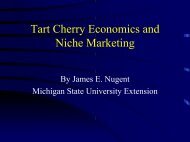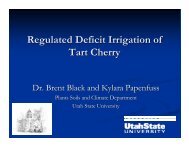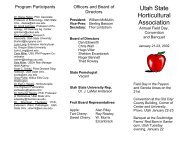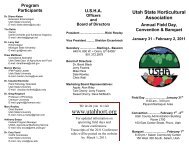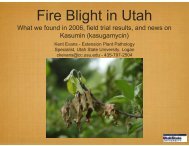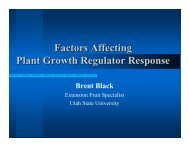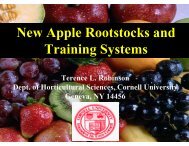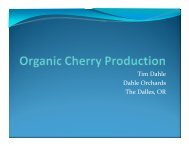RESTRICTED USE PESTICIDES
RESTRICTED USE PESTICIDES
RESTRICTED USE PESTICIDES
Create successful ePaper yourself
Turn your PDF publications into a flip-book with our unique Google optimized e-Paper software.
ACTIVE INGREDIENT TYPE OF <strong>RESTRICTED</strong> <strong>USE</strong>S & RESTRICTION CRITERIA(TRADE NAME) PESTICIDE FORMULATIONSfonofos Insecticide All granular formulations20% and greater.Environmental hazards. Acutedermal toxicity.Emulsifiable concentrates44% and greater.inorganic arsenicals (CCA,ACA, FCAP)WoodPreservativeAll formulations.Human and environmentalhazards.isazofos (Triumph) Insecticide All formulations and uses. Bird, fish and aquatic organismtoxicity.isofenphos (Pryfon) Insecticide 65% liquid formulation for Acute toxicity.termite use.lindane (Lindane) Insecticide All formulations for various Possible oncogenicity*.uses.magnesium phosphide Fumigant All formulations and uses. Inhalation hazard.(Degesch, Detia)metam sodium (Vapam) Herbicide Sewer root control. Human, domestic animal andenvironmental hazards.methamidophos (Monitor) InsecticideAcaricideLiquid formulations 40% andgreater. Dust formulationsAcute dermal toxicity. Residueeffects on avian species.methidathion (Supracide)methiocarb (Mesuroo,Metaldehyde/MethiocarbGranules)methomyl (Lannate,Nudrin)methyl bromide (Brom-O-Gas, Meth-O-Gas, Terr-O-Gas)methyl isothiocyanate(Vorlex Soil Fumigant)methyl parathion(Penncap-M)mevinphos (Phosdrin)nicotine (Fulex, Nico-Fume)oxamyl (Vydate)oxydemeton methyl (MetaSystox R)InsecticideAcaricideAvicideMolluscicideInsecticide2.5% and greater.All formulations and all usesexcept nursery stock,safflower and sunflower.All formulations and outdoorcommercial and agriculturaluses.As sole active ingredient in1% to 2.5% baits (except1% fly bait). Allconcentrated solutionformulations 90% wettablepowder not in water solublebags.Residue effects on avian species.Possible hazard to avian, fish andaquatic organisms.Residue effects on mammalianspecies. Accident history.Fumigant All formulations and uses. Accident history. Acute toxicity.Fumigant Solution-ready to use. Human hazard.Insecticide All formulations and uses. Residue effects on mammalianand avian species. Hazard tobees. Acute dermal toxicity.InsecticideAcaricideInsecticideInsecticideNematicideInsecticideAcaricideAll emulsifiableconcentrates, liquidconcentrates and 2% dusts.Liquid and dry formulations14% and greater forgreenhouse use.All liquid formulations anduses.All formulations and uses.Acute dermal toxicity. Residueeffects on mammalian and avianspecies.Acute inhalation toxicity. Effectson aquatic organisms.Acute oral and inhalation toxicity.Avian toxicity.Reproductive effects.3
ACTIVE INGREDIENT(TRADE NAME)TYPE OFPESTICIDE<strong>RESTRICTED</strong> <strong>USE</strong>S &FORMULATIONSParaquat (Gramoxone) Herbicide All formulations andoncentrates EXCEPT aslisted: pressurized. Sprayformulations containing0.44% paraquat bis (methylsulfate) & 15% petroleumdistillates as actives liquidfertilizers containing 0.025%paraquat dichloride and0.03% atrazine; 0.03%paraquat dichloride & 0.37%atrazine; 0.04% paraquatdichloride & 0.49% atrazine.pentachlorophenolWood All formulations and uses.(Penta, PCP)Preservativepermethrin (Ambush, Insecticide All formulations labeled forPounce)agricultural crop use.phorate (Thimet) Insecticide All granular formulations.Liquid formulations 65% andgreater.picloram (Tordon) Herbicide All formulations exceptTordon 101R and RTU.pronamide (Kerb) Herbicide All uses of 50% wettablepowders.propetamphos (Safrotin) Insecticide 50% emulsifiableconcentrates for indoordomestic use.rotenone (Prentox) Pisicide 2.5-5% emulsifiableconcentrate and 5% and20% wettable powder.sodium cyanide (M-44) Predacide All capsules and ballformulations and uses.sodium fluoroacetate Predacide All solutions and dry bait(Compound 1080)formulations and uses.starlicide (Starlicide, DRC1399)Avicide 98% concentrate birdrepellants.strychnine (Strychnine) Rodenticide Al formulations except handapplication below ground.RESTRICTION CRITERIAHuman toxicological data. Useand accident history.Oncogenicity*, teratogenicity* andfetotoxicity*.Aquatic organism toxicity.Oncogenicity*.Acute dermal and oral toxicity.Residue effects on avian andmammalian species. Aquaticorganism effects.Hazard to non-target plants.Oncogenicity*.Indoor uses restricted.Aquatic organism toxicity.Human inhalation hazard. Hazardto non-target species.Acute oral toxicity. Hazard tonon-target organisms. Use andaccident history.Hazard to non-target organisms.Acute oral toxicity. Hazard tonon-target organisms. Use andaccident history.sulfotepp (Fulex Dithio, Insecticide Smoke generators. Human inhalation hazard.Plantfume 103)sulfuric acid (ASARCO) Desiccant Potato vine dessicant. Acute toxicity to humans.Extremely corrosive.Sulfuryl fluoride (Vikane) Fumigant All formulations and uses. Acute inhalation hazard. Humanacute toxicity.tefluthrin Insecticide Granular product used oncorn grown for seed.terbufos (Counter)Insecticide All granular formulationsNematicide 15% and greater.Environmental hazard.Acute oral and dermal toxicity.Residue effects to avian species.4
ACTIVE INGREDIENT(TRADE NAME)tributyltin methacrylate(Classic Yacht #625)triphenyltin hydroxide (DU-TER)zinc phosphide (Gopha-Rid, ZP)TYPE OF <strong>RESTRICTED</strong> <strong>USE</strong>S & RESTRICTION CRITERIAPESTICIDE FORMULATIONSBiocide Solution-ready to use. Aquatic organism toxicity.Fungicide All formulations and uses. Possible mutagenicity*.RodenticideAll 10% and greater dryformulations. All baitformulations. All uses.Acute inhalation and oral toxicity.Hazard to non-target organisms.*Definitions: Fetotoxicity - Ability to be toxic to the developing fetus.Mutagenicity - Ability to generate or cause mutations.Oncogenicity - Ability to generate or cause tumors.Teratogenicity - Ability to generate or cause birth defects.PRECAUTIONARY STATEMENTAll pesticides have both benefits and risks. Benefits can be maximized and risks minimized byreading and following the labeling. Pay close attention to the directions for use and theprecautionary statements. The information on pesticide labels contains both instructions andlimitations. Pesticide labels are legal documents and it is a violation of both federal and state lawsto use a pesticide inconsistent with its labeling. The pesticide applicator is legally responsible forproper use. Always read and follow the label.Howard DeerExtension Pesticide SpecialistUtah State University Extension is an affirmative action/equal employment opportunity employer and educational organization. We offer our programs to persons regardless of race, color,national origin, sex, religion, age or disability. Issued in furtherance of Cooperative Extension work, Acts of May 8 and June 30, 1914, in cooperation with the U.S. Department of Agriculture,Robert L. Gilliland, Vice-President and Director, Cooperative Extension Service, Utah State University, Logan, Utah.5



